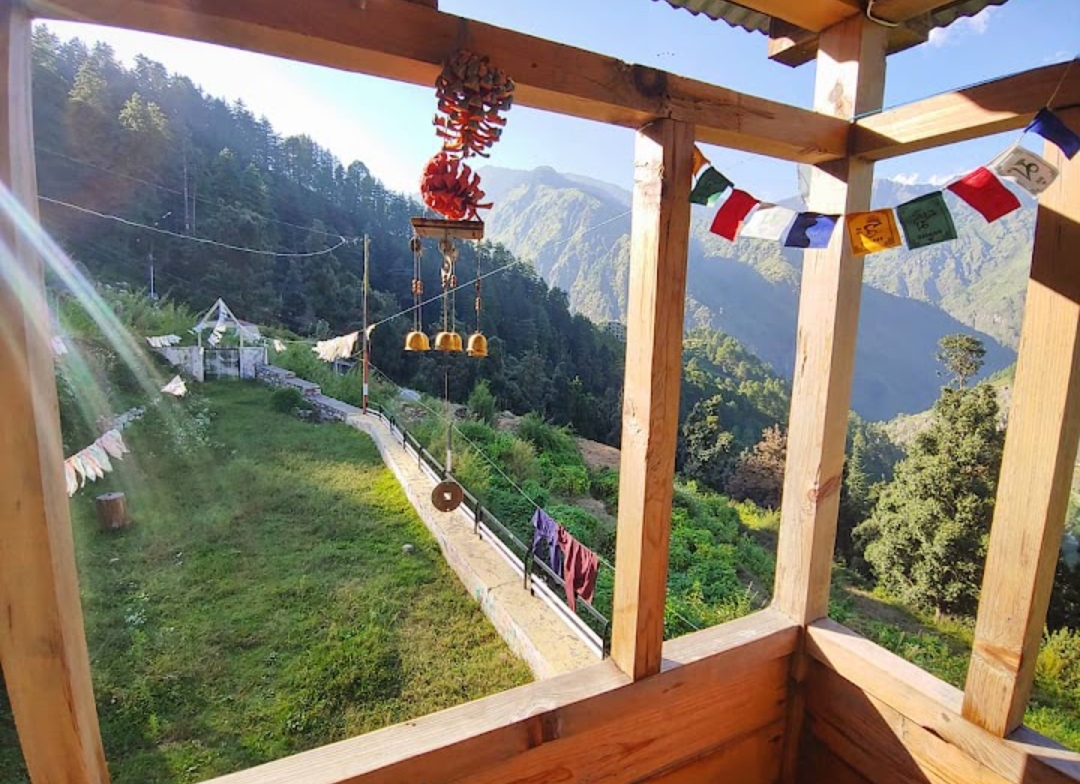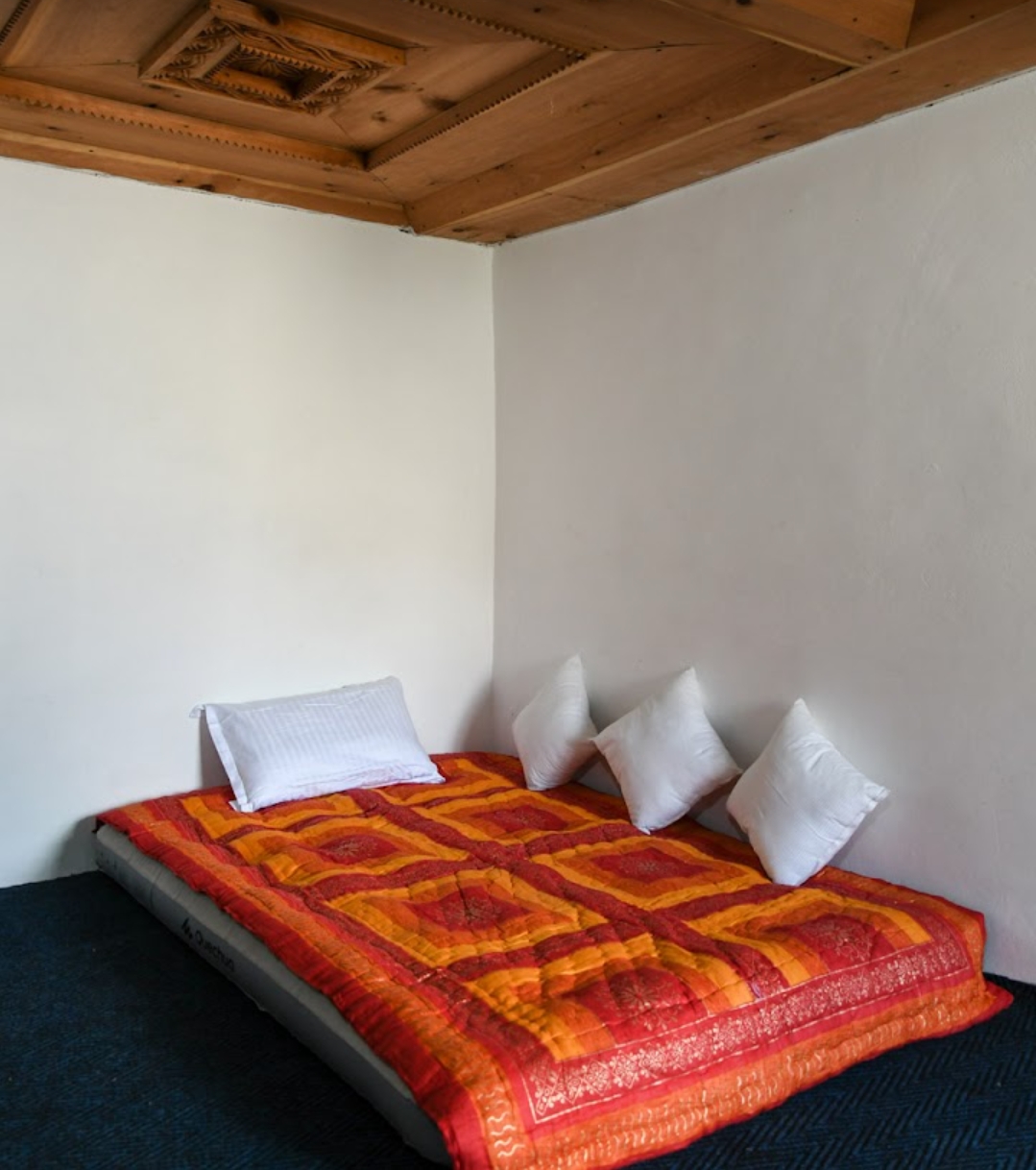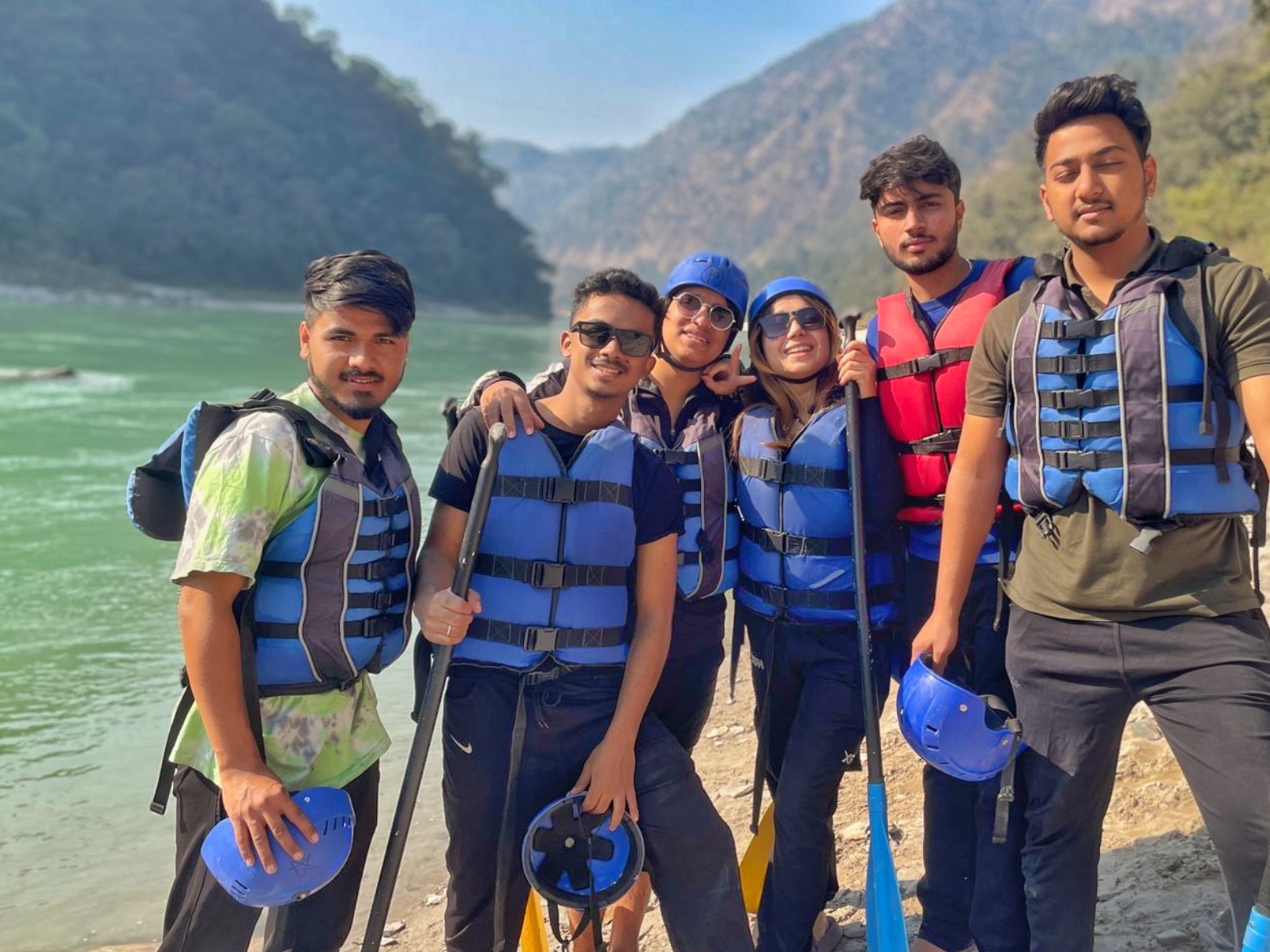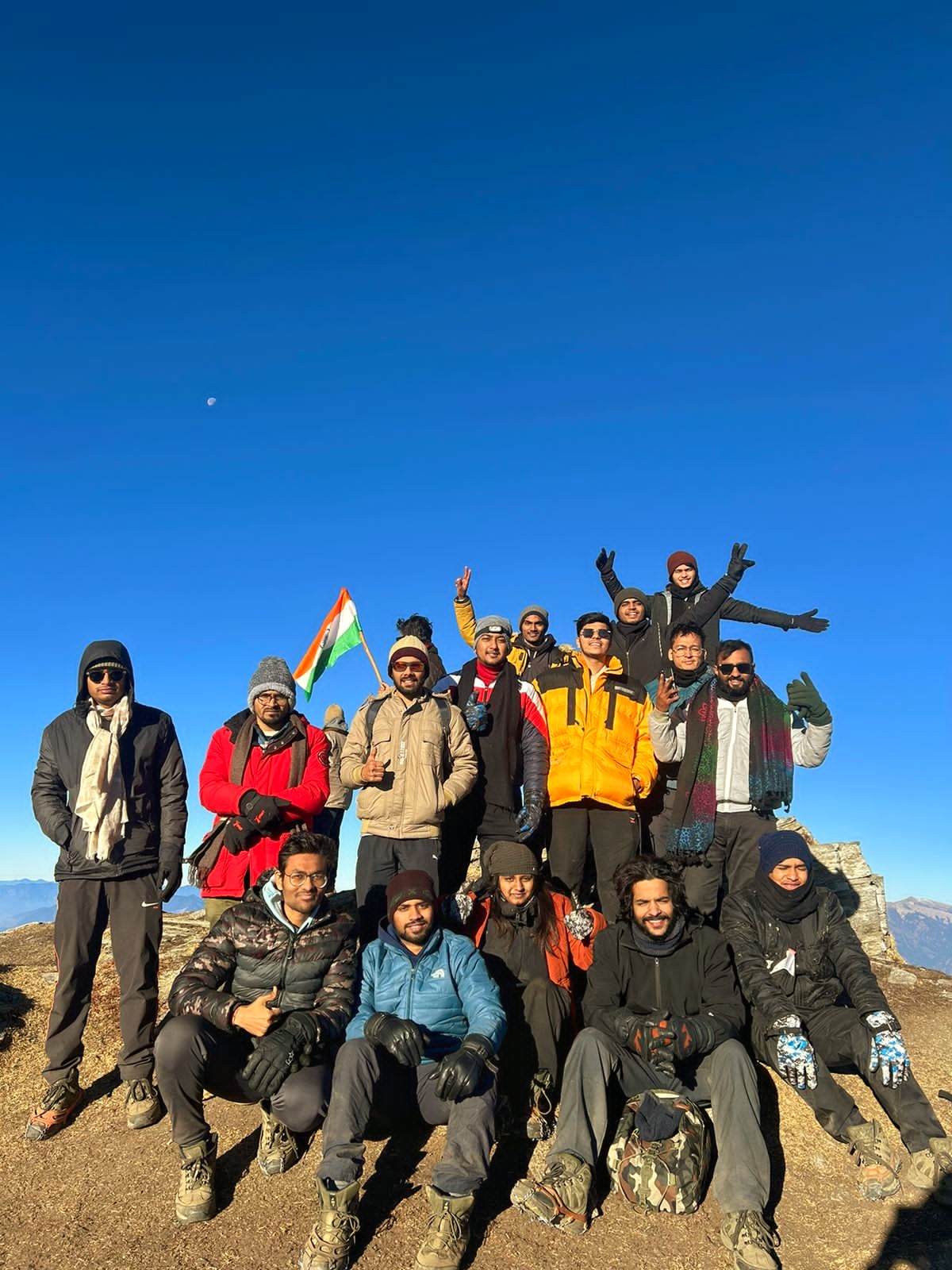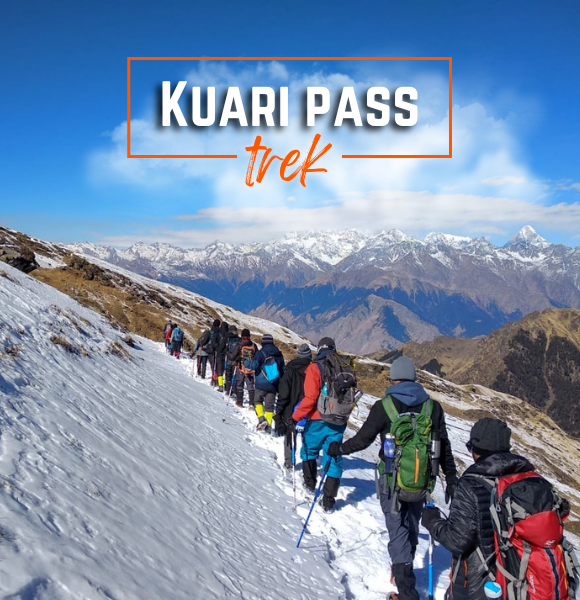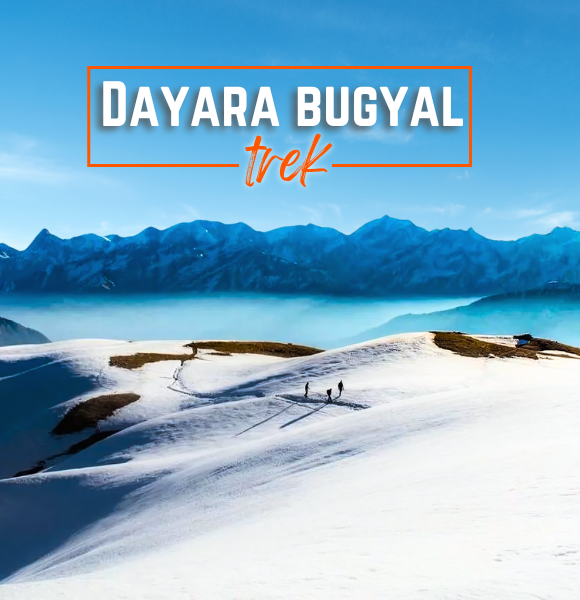Trek Grade
Easy - Moderate
Highest Altitude
12,500 ft
Base Camp
Sankri
Best Time
Nov - Feb
Kedarkantha Trek
Starting from INR 8,000
Package Variant
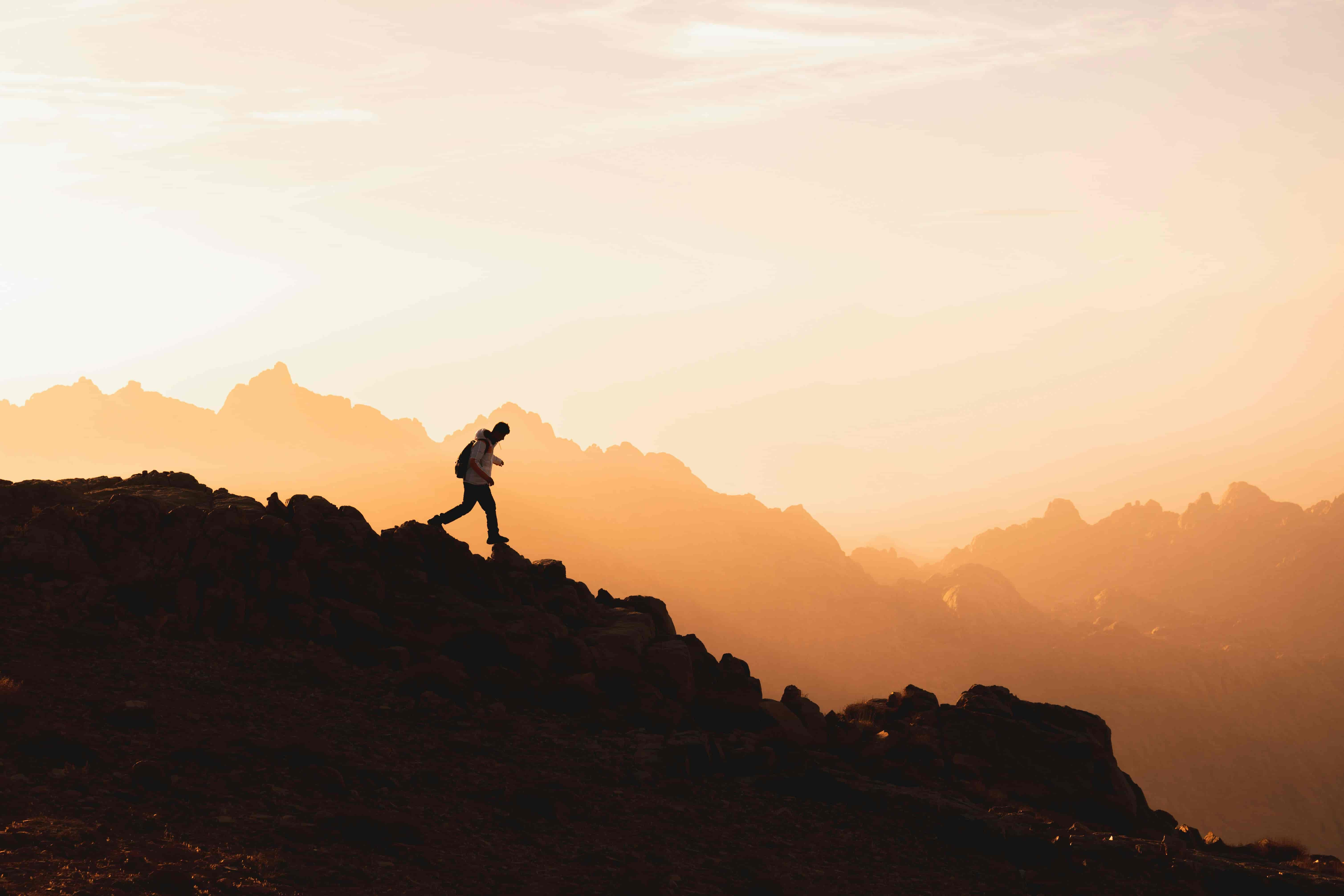
from Dehradun to Dehradun

from Delhi
to Delhi

- 🧥 Free poncho / raincoat
- 🎫 Certificate
- 🎁 Free Rs 500 voucher
- 🎒 10% flat discount on rentals
- 🏨 20% discount of Tripli Hotels
- 🚌 10% discount on volvo bus booking
- 🧥 Free poncho / raincoat
- 🎫 Certificate
- 🎁 Free Rs 500 voucher
- 🎒 10% flat discount on rentals
- 🏨 20% discount of Tripli Hotels
- 🚌 10% discount on volvo bus booking
Kedarkantha Trek
Kedarkantha Trek is marked as one of among trekking wonderlands of winter in India. This is located in a small district in Uttarkashi of Uttarakhand. It offers absolutely stunning surroundings of a snow-covered landscape, strange-looking pine trees as well as an amazing and wide view of the mountains. This trek is special in a way that its difficulty grade is beginner friendly and can be attempted by a first-time trekker too. The Kedarkantha trek by Dream Trips has been well-designed and exquisitely prepared in such a way that offers ease and safety. For less experienced trekkers or for seasoned trekkers that have been in the Himalayas for a long time, they would find the kedarkantha trek so spectacular.
Why you should choose Dream Trips for kedarkantha trek?
One of the winter trekking in India that remains famous is the Kedarkantha trek that promises stunning beauty of the snow-covered trails and is amidst the grandeur of the Himalayas. When it comes to trekking, few names have earned a reputation such as Dream Trips which stands out for offering a safe and original experience whilst ensuring utmost quality throughout. Even as one enjoys the trek, Dream Trips ensures every detail is flawlessly executed, with its team of experienced guides, high altitude trekking team and a first-rate itinerary that is supported by solid plans.
The trek begins from Sankri village which is picturesque and slighly about 210km from Dehradun. Sankri is also a point from where Kedarkantha Trek and some other treks can be made. Hence, this is where your journey towards the summit commences. There are different trails in the Kedakantha trek that are outlined by Dream Trips, they comprise of scrub lands, and the open fields and all of them are in the direction of the breathtaking Kedarkantha Summit, which is situated at approximately 12,500ft.
Best Months for Kedarkantha Trekking
Kedarkantha is best visited during the months of December to March. The snow covers the path converting it into a winter paradise. This trekking place is the most suitable for the people who wish to do snow trekking. During this said month, blue skies coupled with chilly days are what can be expected hence making trekking and other outdoor events ideal.
Winter is the best season to travel to Kedarkantha; however, it is not the only time when the place can be visited. The period from March to April is called the spring season. At this time, most of the snow will melt away, and various regions will be filled with blooming rhododendrons. Summer (May - June) and autumn (September - November) are the best months to visit the place as they have very less tourist crowds; therefore, if one wants to avoid being surrounded by a huge rush, then these durations are best for the visit.
Kedarkantha Trek Itinerary
Because the Kedarkantha Trek is one of the longer treks, spanning five days and four nights, it is possible to renew your bond with nature and all its tranquility for quite a long period. Starting from Sankri the places include Juda Ka Talab, the Kedarkantha’s base camp then – naturally – the Kedarkantha’s peak.
Grading the Difficulty of KedarKantha
To simple say, KedarKantha Trek is easy to moderate in difficulty zone. While climbing up, there are a few obstacles but no more than just a few. The highest difficulty level is the height, which ranges from about 40 to 60 degrees and is not very technical. Conversely and goal-oriented approaches, then it is straightforward and suitable for beginners and others. The last leg of the trek or kedarkantha peak about – “dream trips” world challenge will teach one to be mentally strong and focused in all endeavors.
A Great Trek for Newbies
This Trek is made for beginners as the dificulty level is mild to moderate and that is why there is less or no need of any previous experience for trekkers. Dream Trips take care of your capabilities and go out of their way to ensure you reach the top and explore the market without incurring any cost. The use of high-tech mission specific teams to coordinate the summit efforts will facilitate the summiting of the keharkanta peak.
Kedarkantha Trek Highlights
- Awesome Scenes: Due to the beauty of its top Panoramic views surrounding the peak. It is an area where it is easy for one to go trekking, sit at the peak and enjoy the breathtaking views of Swargarohini, Bandarpoonch, and Black Peaks.
- As one leaves the Sankri zone, the panorama changes with great speed to enchanting and lofty snow-clad meadows and jagged mountains.
- Camping Under The Stars: The Kedarkantha Trek campers in winter snow somewhere on the trek probably blanks out this experience of sleeping in between mountains with frozen environment and complete silence accompanied by glimmering stars. Such experiences, however, are not what you would have to fret over when you contact Dream Trips for organizing your camping.
- Varied and Abundant Wildlife: The specific trek passes through the Govind National Park and Wildlife Sanctuary which is rich in its flora and fauna. The Himalayan Monal or the Woodpecker can be seen and heard as well as a few other birds, and some are quite lucky in sighting the snow leopard.
- Meeting with the locals: Customers who wish to interact with Sankri villagers and residents of other localities along the trek will be satisfied because these people have lived here for years and have many fascinating stories including legends about the mountains and areas nearby.
- Security and Skilled Assistance: It is known both in marketing strategy and in practice that safety can be sold. No matter the size of the group, be it certified trek leaders, guides or the professional crew – you will always be in good hands.
What makes Dream Trips stand apart?
Dream Trips is also a trekking business but most of all it’s a family that strives to make the day special in one’s life. With its roots in the Himalayas, Dream Trips hopes and aims to make the trek a memorable one. In fact the team has a lot of hands-on detail to offer so you’re placed right in the middle of your Kedarkantha Trek made special by Dream Trips.
Whether you are trekking alone or with friends and family, the team at Dream Trips assures you of a safe, commemorative and most importantly a fun trip. Further more, the personnel of Dream Trips do not wait for the trek to start to help – they give you trekking tips and suggestions for fitness and preparedness beforehand.
Conclusion
Kedarkantha Trek is probably the cutest and simplest of all the treks attempted in the Indian Himalayas. It blends adventure, immense beauty of the sceneries and diversity of culture. This trek is ideal for every individual who is looking for a snow trek and beautiful scenery regardless of whether they are a beginner or an advanced hiker. The services offered by Dream Trips will guarantee your safety and ease, while also providing you with memories that are one of a kind.
With owned heavy fall across many appealing regions of Indian subcontinent, it is the perfect time to plan the Kedarkantha Trek with Dream Trips who will provide an unparalleled experience in the Himalayas.
Trekking tips to be a pro
Essential Trekking Tips with The Dream Trips to trek like a pro trekker. Planning your next trek? Check out these essential trekking tips from The Dream Trips! Whether you’re a beginner or a seasoned trekker, these simple yet powerful tips will help you stay safe, pack smart, and enjoy every step of your adventure. From staying hydrated to pacing yourself, each tip is designed to make your journey smoother and more enjoyable. Save this guide and be trek-ready for your next mountain adventure! 👣
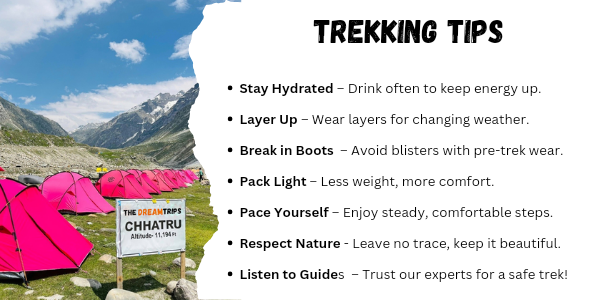
Know Everything About Acute Mountain Sickness
Acute Mountain Sickness (AMS), often called altitude sickness, is a condition that can affect trekkers and travellers at high altitudes – usually above 8,000 feet. When you reach these elevations, the air has less oxygen, and this sudden change in oxygen can make it harder for your body to adjust, causing symptoms of AMS. As a leading adventure travel company, Dream Trips ensures all trekkers are well-informed and prepared for these challenges, especially on high-altitude Himalayan treks. With Dream Trips expertise in high-altitude trekking, you can explore the stunning Himalayan landscapes with confidence. Every trek is designed with safety and acclimatization in mind, ensuring that you can fully enjoy the adventure while minimising the risk of AMS. Trust team Dream Trips to guide you through safe and unforgettable high-altitude experiences

Day Wise Detailed Itinerary
- Morning: Arrive in Dehradun, the gateway to your amazing trek. Meet our friendly team from The Dream Trips at the designated meeting point for a warm welcome.
- Transportation: Hop on a comfortable shared jeep to Sankri, a charming village that marks the starting point of your Kedarkantha trek. Enjoy stunning views of lush valleys and towering peaks along the way.
- Lunch: Once you reach Sankri, savor a delicious vegetarian meal prepared by our expert chefs. At The Dream Trips, we focus on providing nutritious meals to fuel your adventure.
- Evening: Settle into your cozy tented accommodation and take some time to explore the surrounding area. Breathe in the crisp mountain air and soak up the beauty of nature.
- Dinner: Enjoy a hearty dinner with your fellow trekkers, sharing excitement about the adventure that lies ahead.
- Overnight Stay: Rest comfortably in your tents, recharging for the journey ahead.
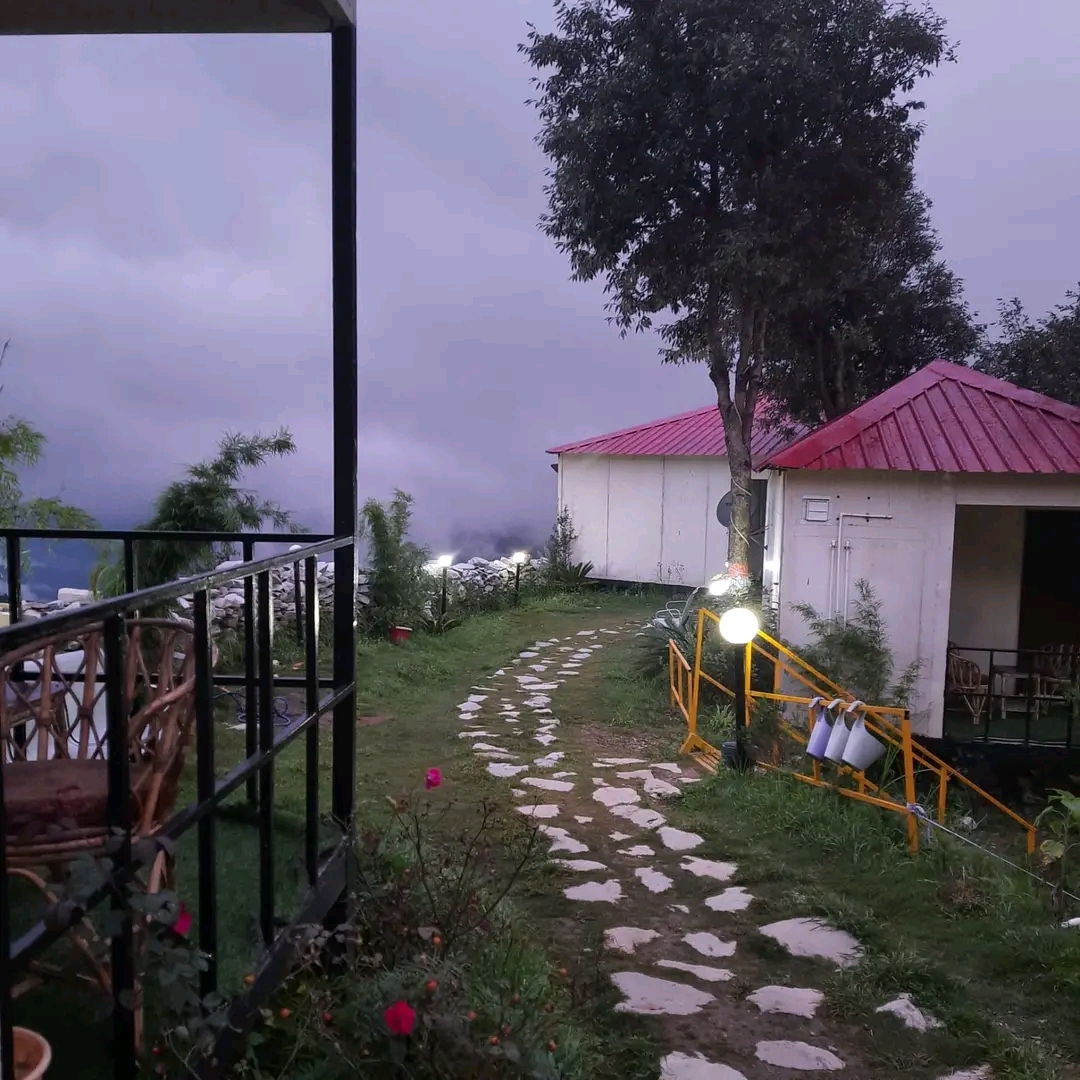
- Morning: Start your day with a warm cup of lemon tea, followed by a tasty breakfast featuring Aloo Paratha and fresh fruits.
- Trek Begins: Set off on your trek to Juda Ka Talab, a picturesque glacial lake surrounded by tall pine trees. The trail is enchanting, filled with beautiful sights and sounds of nature.
- Lunch: Enjoy a nourishing lunch along the trail, keeping your energy levels high.
- Afternoon: Continue your trek, marveling at the breathtaking landscapes and keeping an eye out for local wildlife.
- Evening: Arrive at Juda Ka Talab, where you can relax by the serene lake and enjoy the peaceful atmosphere.
- Dinner: Gather around the campfire for a delightful dinner, sharing stories and laughter with your trekking companions.
- Overnight Stay: Sleep peacefully in your tents, surrounded by the sounds of nature
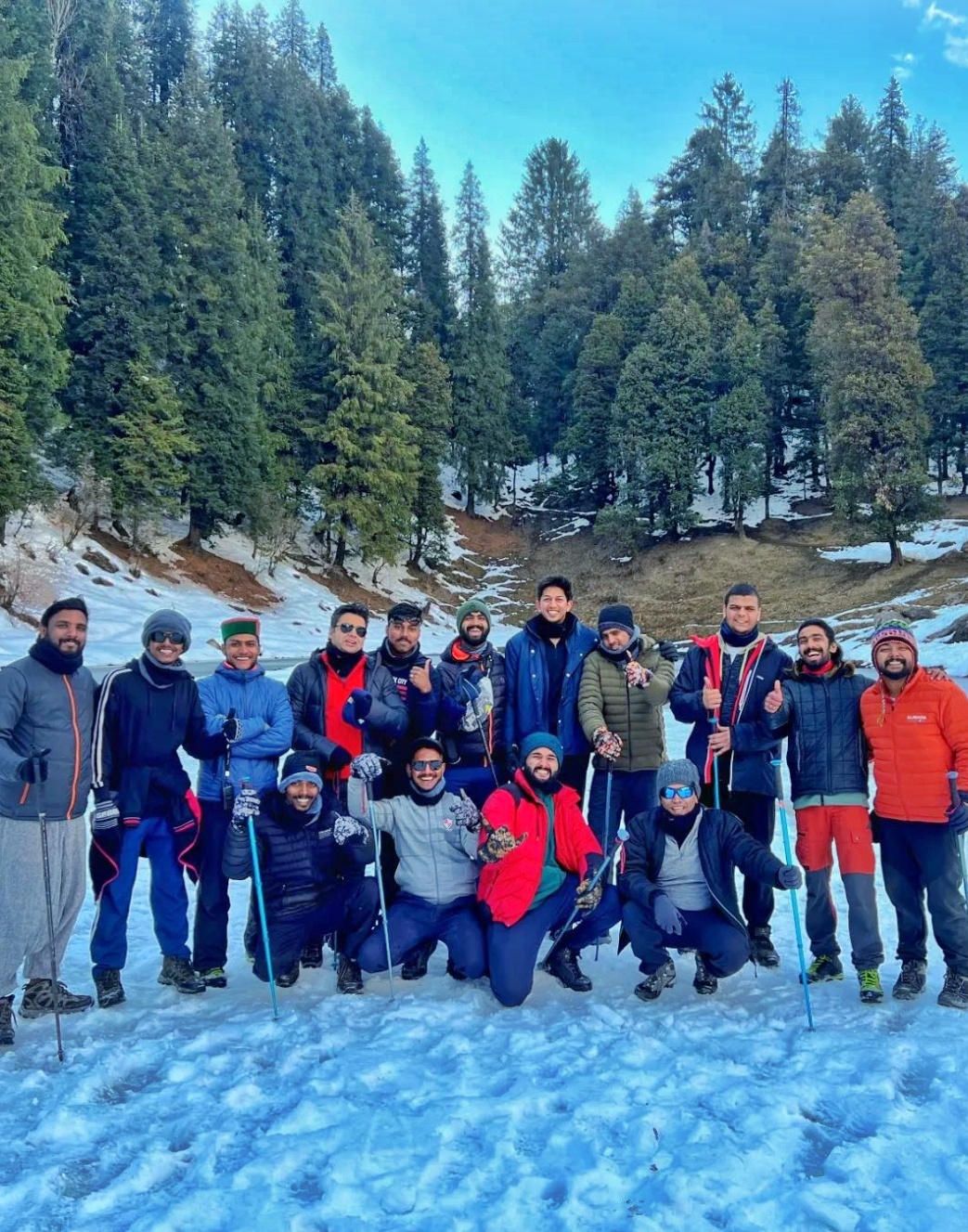
- Morning: After a nourishing breakfast, pack your bags and prepare for a day of trekking to the Kedarkantha Base Camp.
- Trek Highlights: Experience awe-inspiring views of snow-capped peaks as you trek through scenic meadows and dense forests.
- Lunch: Enjoy a packed lunch during your trek, ensuring you stay energized for the day's adventure.
- Afternoon: Arrive at the base camp, where you’ll be treated to stunning views of Kedarkantha Peak. Take pictures and soak in the beauty around you.
- Evening: Settle into your camp and relax. Spend time bonding with fellow trekkers, sharing experiences and making new friends.
- Dinner: Enjoy a hot and delicious dinner as you prepare for the exciting summit day ahead.
- Overnight Stay: Rest well in your tents, dreaming of the summit as its your trem trip with The Dream Trips

- Early Morning: Wake up early for a warm cup of tea and a quick breakfast. Get ready for the summit day!
- Trek to the Summit: Begin your ascent to the Kedarkantha Summit. The climb is challenging, but the views from the top are breathtaking. Experience the thrill of standing atop a peak surrounded by the grandeur of the Himalayas.
- Summit Celebration: Capture the moment with photographs and enjoy the fresh mountain air. Celebrate your achievement with your trekking family from The Dream Trips!
- Descent: Trek back down to Juda Ka Talab, enjoying the scenic beauty along the way.
- Lunch: Stop for lunch by the lake, relaxing and reflecting on your successful summit.
- Evening: Arrive back at camp, where you can unwind and celebrate your achievements.
- Dinner: Savor a hearty dinner with your trekking companions, sharing stories from the day.
- Overnight Stay: Sleep soundly, filled with joy from your accomplishment.

- Morning: Enjoy a warm breakfast and pack your bags for the return trek.
- Trek Down: Begin your descent back to Sankri, taking in the last glimpses of the stunning landscapes.
- Lunch: Enjoy a final meal in Sankri, celebrating your successful trek and the wonderful memories created.
- Transportation: Board the shared jeep for the journey back to Dehradun.
- Arrival: Arrive in Dehradun, filled with amazing stories and experiences to share. And now you call finally call it your Dream Trip
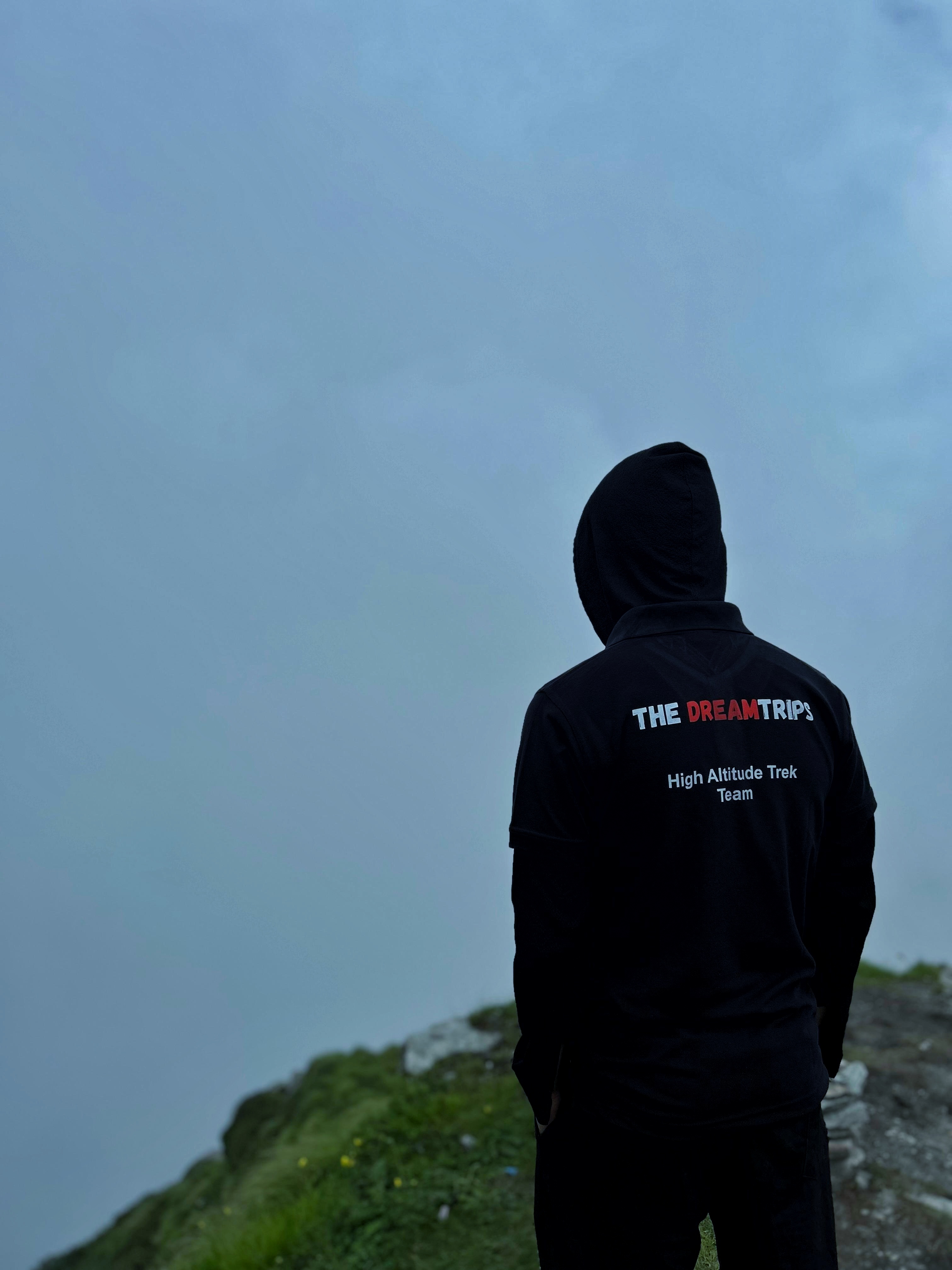
Kedarkantha Trek Route Map

Altitude chart
Inclusions
-
Accommodation: Enjoy 3 nights in tented accommodation at our scenic campsites on a sharing basis, providing a unique outdoor experience. Additionally, you will spend 1 night in a comfortable guest house, ensuring a cozy and restful stay.
-
Meals: Savor freshly cooked meals throughout the trek, starting with dinner on Day 1 and including breakfast and lunch on Day 5. Our meals are simple, nutritious, vegetarian, and designed to keep you energized, featuring non-repeated menu options to keep your taste buds satisfied.
-
Optional Transport: For added convenience, we offer shared jeep transport from Dehradun to Raithal and back, making your travel arrangements smooth and easy.
-
Trek Insurance: While trek insurance is optional, The Dream Trips highly recommends it for all trekkers. This insurance covers unexpected events during your trek, ensuring peace of mind. The cost of trek insurance starts from INR 210.
-
Trek Equipment: We provide essential trekking equipment, including sleeping bags, sleeping tents, kitchen tents, dining tents, and toilet tents, ensuring you have everything you need for a comfortable trek.
-
Amenities: Enjoy all necessary amenities, such as utensils, sleeping mattresses (black foam mats), crampons, and gaiters for snow, ensuring you are well-equipped for various terrains.
-
Health & Safety: Your safety is our priority. We provide a comprehensive First Aid Box, oxygen cylinders, stretchers, oximeters, and BP machines to ensure health and safety throughout your adventure.
-
Permits: We handle all necessary forest permits and camping permission fees, allowing you to focus on enjoying your trek without worrying about the logistics.
-
Trek Crew: Experience the support of our dedicated trek crew, including a high-altitude chef, helpers, trek leaders, and guides, who are all committed to making your trek enjoyable and safe.
-
Porters & Mules: To ease your load, we provide porters and mules to carry all trekking equipment, rations, and vegetables, allowing you to trek with comfort and focus on the breathtaking scenery.
Exclusions
-
GST (Goods and Services Tax): A 5% GST charge is mandatory and will be applied to the total cost of your trek.
-
Meals and Accommodation Not Included in the Itinerary: Any meals or accommodations outside of what is specified in the itinerary are not included.
-
Transportation Costs: Any bus or airfare to or from the trek start or end point is not covered in the package.
-
Personal Medical Expenses: We advise all trekkers to carry their own medications and be prepared for any personal medical needs during the trek.
-
Personal Services: Charges for personal services such as laundry, phone calls, alcoholic beverages, and bottled water are not included.
-
Entrance Fees: Entrance fees for monuments, monasteries, museums, or temples are not included and should be paid on the spot.
-
Offload Charges for Personal Baggage: If you wish to offload personal baggage, the charges are INR 365 per day, per bag if paid online (or INR 1500 at base camp). Please note that the weight limit for offloaded bags should not exceed 10 kg.
-
Emergency Evacuation Charges: Any costs incurred for emergency evacuation are not included and should be planned for accordingly.
-
Additional Services: Any services or activities that are not specifically mentioned in the inclusions section will not be provided.
Pro Bag-Packing Tips
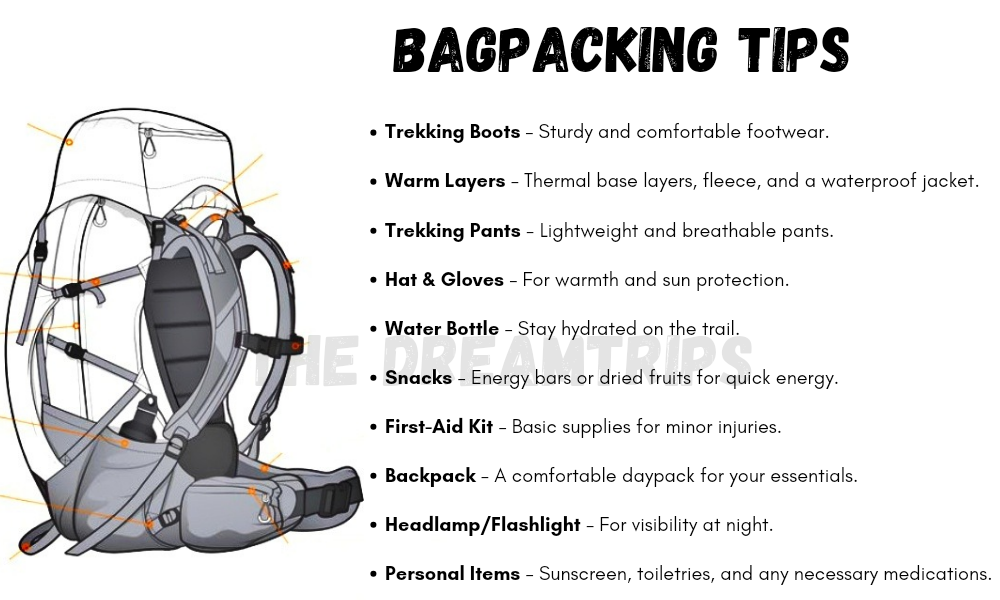
Head Gears
Heading out for a trek? Don’t forget to carry headgear to protect your beautiful face and head from the sun, wind, and dust! It’s an essential accessory that keeps you safe and comfortable throughout your adventurous journey. So, make sure you pack it before you step out into nature!
- Head Lamps – When trekking at night, headlamps are essential to illuminate your path while keeping your hands free. Headlamps come in different sizes and lumens, so it is essential to choose one that suits your needs.
- Hats or Cap – Caps or hats are also necessary when trekking in different weather conditions. Caps protect your head from the wind and freezing temperatures at night, while hats provide shade and protection from the sun during the day. It’s essential to ensure that your hat has a strap to prevent it from being blown away by the wind.
- Sunglasses – Sunglasses are also essential for trekking. Your sunglasses should protect your eyes from harmful UV rays and fit your face perfectly to avoid falling off while climbing, jumping, or crossing obstacles. The glass of your sunglasses should also be designed for different weather conditions to provide optimal visibility.
- Buff / Balaclava – Lastly, a buff or balaclava is a must-have to protect your mouth or neck from extreme temperatures and keep them warm. Buffs and balaclavas come in different materials, thicknesses, and designs, so it’s important to choose one that suits your needs and preferences. Depending on the weather conditions and your activities, you can wear them as neck warmers, face masks, or headbands.
With these essential items, you can enjoy trekking safely and comfortably, no matter the weather or time of day.
Clothes
Layering is important for different seasons when trekking. When planning a high-altitude trek, it is important to prepare for the cold weather. Wearing layers is the best approach as it provides both protection and flexibility when the weather changes frequently in the mountains. Layering helps to trap heat and keep your body warm, while at the same time allowing you to easily adjust your clothing as the temperature fluctuates. By wearing layers, you can enjoy your trek comfortably and stay safe in the unpredictable mountain weather
- For spring, summer, and monsoon treks, consider wearing three layers: a woollen sweater, a fleece, and a padded jacket.
- For autumn treks, add one more fleece layer to make it four layers.
- For winter treks, you may need five layers with thermals, a woollen sweater, two fleeces, and a padded jacket.
- T-shirt/sleeve shirt– Bring three T-shirts and two quick-dry trek pants, wearing one and carrying the others. Long sleeve shirts help to protect from sun UV rays. We recommend synthetic T-shirts as they get dry quickly when they get wet.
- Hiking / Trekking Jacket– down jackets (-5 to-10 C) or two-three-layer jackets.
- Thermals– at least two pairs of thermals help keep the body warm during cold weather.
- Undergarments– you can carry them according to your habitual and hygiene requirements.
- Gloves– 1 pair of gloves will keep your hand warm and nice.
- Trek Pants– Bring 2 to 3 comfortable trekking pants. Trekking pants play a significant role, as they are designed for comfort and mobility, making trekking easier. It should be Synthetic so that it gets dry quickly when wet.
- Rain Wear– you can carry a raincoat or Poncho. During long rains and snowfalls, the waterproof jackets start leaking. Still, the Poncho and raincoats keep you dry, so choose accordingly.
Tip: If you choose a raincoat on your trek, carry a small waterproof cover so things inside your backpack can’t get wet. If you carry a Poncho, you don’t need to worry. It protects both you and your backpack.
Foot Gears
- Trekking shoes which are waterproof and have ankle support. Walking / Hiking sandals which can be used off the trek, i.e., in the morning and evening hours when you reach the campsite, basically to get your feet rest from heavy boots, sometimes used for crossing streams and rivers, it’s more comfortable and safer than crossing barefoot or wetting your shoes. Sneakers (Optional) can be worn for normal driving days or used around the camp.
- Socks– you should at least carry 3 to 4 pairs.
- Microspikes & Gaitors will be provided by The Dreamtrips when required. You don’t have to carry them.
How To Reach?
By Air:
Jolly Grant Airport is the nearest airport to Dehradun by flight, almost 25km from the city. You can find regular flights from Delhi to Dehradun.
However, if you plan to reach Dehradun by flight, it is better to come one day in advance.
By Train
Two express trains are convenient if you want to reach Dehradun from Delhi by train. With the train, it is an overnight journey. The two trains are mentioned below:
Nandadevi Express – Train no: 12205 (Departure 11:50pm; Arrival – 5:40am)
Dehradun Express – Train no: 12687 (Departure – 9:10pm; Arrival – 5:00am)
By Bus
From Delhi, you can find a regular bus service to Dehradun. ISBT Kashmere Gate is the central bus station in Delhi, from where you will find both AC and non-AC buses for Dehradun.
However, taking government buses from Kashmere Gate ISBT is always better. The bus will drop you at Dehradun ISBT, and then we will send our staff who will pick you up from Dehradun Railway Station, so you need to reach there.
Trek Preparation Guide
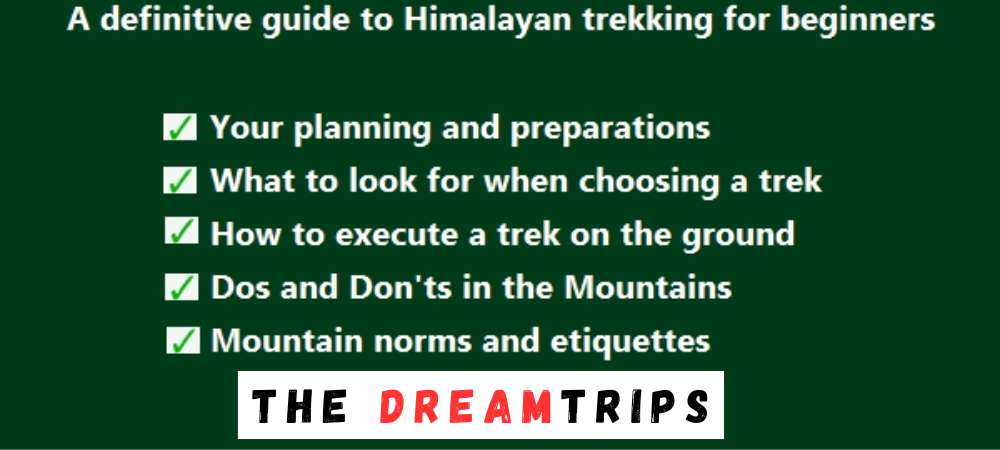
Fitness Target
For Easy – Moderate Treks – In order to be well-prepared for your upcoming trek, it is recommended that you focus on building your endurance by aiming to cover a distance of 4.5 kilometers in less than 45 minutes. This will help you to develop the necessary stamina and strength required to successfully complete your journey.
How to Achieve This Fitness Target?
To start preparing for your trek:
- Try jogging for at least five days every week.
- If you find 5 km too difficult at first, begin with 2 km and gradually increase over 2-3 weeks.
- Once you feel more comfortable running 5 km, focus on improving your speed gradually on a daily basis.
It is important to ensure that you can consistently complete 4.5 km in under 40 minutes for at least two weeks before your planned trek. Allow yourself 6-8 weeks to prepare physically for the journey.

Recommended Training & Exercises
Trekking is a demanding activity that requires good cardiovascular endurance, muscular strength, and overall fitness. To help you prepare for your trek, incorporating bodyweight exercises into your training routine can be an effective way to build strength, improve stability, and enhance endurance, all of which are crucial for a successful trek. In this regard, here’s a breakdown of body weight exercises categorized by the specific body parts they target and the benefits they offer during trekking.
1. Lower Body Exercises
Lower body exercises like squats and lunges are great for building lower body strength, essential for trekking.
a. Squats
Squats are an excellent exercise for building lower body strength, essential for trekking. They target the quadriceps, hamstrings, glutes, and calves. Solid quadriceps and glutes provide power for ascending and tackling uphill climbs, while vital hamstrings aid stability during descents. This is particularly helpful in navigating uneven terrain during trekking.
How to perform Squats Exercises:
- Stand with feet shoulder-width apart, toes pointing slightly outward.
- Lower your body by bending your knees and hips, keeping your back straight.
- Lower until your thighs are parallel to the ground or as low as comfortable.
- Push through your heels to return to the starting position.
b. Lunges
Lunges target the quadriceps, hamstrings, glutes, and calves. They improve lower body strength, balance, and stability, crucial for maintaining control on rocky trails and steep slopes. Additionally, they enhance flexibility, reducing the risk of injury while trekking.
How to Perform Lunge Exercises:
- Stand with feet hip-width apart, hands on hips or sides.
- Take a step forward with one foot, lowering your body until both knees are bent at 90-degree angles.
- Push through the heel of your front foot to return to the starting position.
- Repeat on the other side, alternating legs.
2. Upper Body Exercises
Upper body exercises such as push-ups and pull-ups effectively strengthen the upper body, especially the chest and shoulders, which are essential for carrying a backpack during treks.
a. Push-Ups
Targets: Chest, shoulders, triceps, and core.
Benefits for Trekking: Push-ups are an effective exercise to strengthen the upper body, especially the chest and shoulders, essential for carrying a backpack during treks. Improved upper body strength will also help maintain posture and stability while traversing challenging terrain.
How to Perform Push-Ups Exercises:
- Start in a plank position with hands shoulder-width apart and body in a straight line from head to heels.
- Lower your body by bending your elbows until your chest nearly touches the ground.
- Push through your palms to return to the starting position.
- Keep your core engaged throughout the movement.
b. Pull-Ups/Bodyweight Rows:
Targeting the back, biceps, and shoulders can significantly benefit trekking. You can strengthen these muscle groups by performing pull-ups or bodyweight rows and improve your posture and balance while carrying a backpack. Additionally, more muscular back muscles can help reduce the risk of back strain and fatigue during long treks, making your journey safer and more comfortable.
3. Core Exercises
Core exercises like planks and Russian twists can help strengthen the core muscles, which are crucial for maintaining stability and balance while trekking on uneven terrain.
a. Planks
Targets: Abdominals, obliques, and lower back.
Benefits for Trekking: Planks are an effective exercise that helps strengthen the core muscles. These muscles are crucial for maintaining stability and balance while trekking on uneven terrain. A strong core also helps improve posture, reducing the risk of back pain and fatigue during extended hikes.
How to Perform Planks Exercises:
- Start in a plank position with elbows directly under shoulders and body in a straight line from head to heels.
- Engage your core and hold the position, avoiding sagging or arching the back.
- Keep breathing steadily and hold for the desired duration.
b. Russian Twists
Targets: Obliques, abdominals, and lower back.
Benefits for Trekking: Russian twists engage the core muscles, particularly the obliques, improving rotational stability and balance. Enhanced core strength helps prevent injuries and improves overall performance during trekking.
How to Perform Russian Twist Exercises:
- Sit on the ground with knees bent and feet flat, leaning back slightly to engage the core.
- Clasp hands together and twist the torso to one side, bringing the hands towards the ground beside the hip.
- Return to the centre, then twist to the other side.
- Continue alternating sides for the desired number of repetitions.
4. Full Body/Cardiovascular Exercises
Full-body/cardiovascular exercises like burpees and mountain climbers are excellent for improving cardiovascular endurance, strength, and agility.
a.Burpees
Burpees are an excellent full-body exercise that targets your legs, chest, arms, and core. This exercise dramatically benefits trekking enthusiasts, improving cardiovascular endurance, strength, and agility. Regularly incorporating burpees into your workout routine can enhance your overall fitness level, which can help you endure long hikes and rugged terrains with ease.
How to Perform Burpees Exercises:
- Start in a standing position.
- Squat down and place hands on the ground.
- Jump feet back into a plank position.
- Perform a push-up.
- Jump feet back to the squat position.
- Explosively jump up into the air, reaching overhead.
- Land softly and repeat the sequence.
b. Mountain Climbers
Mountain climbers target the core, shoulders, chest, and legs. This dynamic, full-body exercise can significantly improve cardiovascular endurance and agility. It is an excellent functional workout for trekking preparation as it engages both the upper and lower body muscles while strengthening the core muscles.
How to Perform Mountain Climbers Exercises:
- Start in a plank position with hands shoulder-width apart and body in a straight line from head to heels.
- Drive one knee towards the chest, then quickly switch legs, alternating in a running motion.
- Keep the core engaged and the hips stable throughout the movement.
- Continue at a moderate to fast pace for the desired duration.
Incorporating bodyweight exercises into your training routine can help you build strength and endurance and prepare your body for the physical demands of trekking. Consistency and proper form are crucial to maximizing the benefits of these exercises and ensuring a safe and enjoyable trekking experience. Engaging your core muscles, including obliques, abdominals, and lower back, with Russian twists can improve your rotational stability and balance, preventing injuries and enhancing overall performance during trekking.
When incorporating strength training exercises into your workout routine, it’s essential to maintain proper form and technique to avoid injury. Start with lighter weights and gradually increase the intensity as you progress, focusing on compound exercises targeting multiple muscle groups simultaneously. Some examples of practical strength training exercises for trekking include squats, lunges, deadlifts, and pull-ups.
Remember to give your muscles time to recover between workouts, and remember to stretch before and after your workouts to prevent injury and improve flexibility. Combining strength training with jogging and proper stretching allows you to take your fitness to the next level and confidently tackle even the most challenging treks.
Food Provided By Us During Kedarkantha Trek
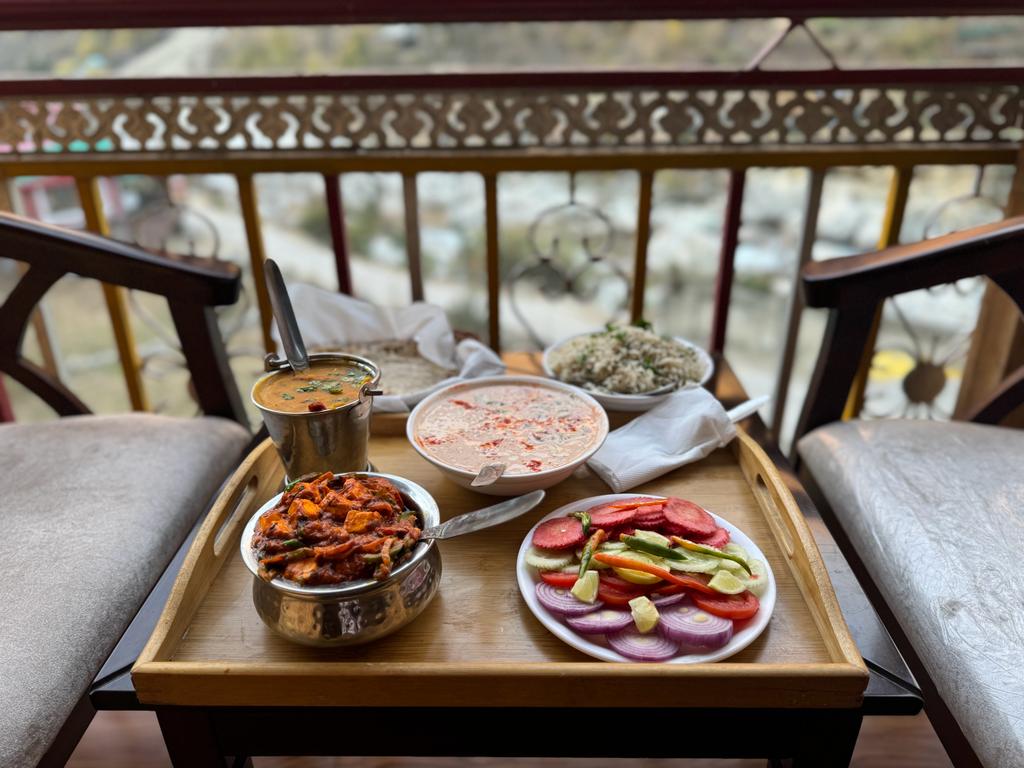
Delicious Indian Vegetarian Meals on Your Trek with The Dream Trips
At The Dream Trips, we take pride in providing our trekkers with wholesome and flavorful Indian vegetarian meals throughout your adventure. Our carefully curated menu primarily consists of Indian bread, a variety of vegetables, lentils, rice, and delightful desserts, ensuring a satisfying dining experience after a day of trekking. Each day, you will enjoy three nutritious meals: breakfast, lunch, and dinner, alongside evening snacks that include tea, snacks, and comforting soup to warm you up before dinner. On longer trekking days, we also provide packed snacks to keep your energy levels high.
Our meal planning is based on extensive research into trekkers’ nutritional requirements, taking into account the challenges posed by altitude and weather conditions. The meals we serve are perfectly balanced, packed with essential calories, carbohydrates, vitamins, protein, fiber, and minerals to fuel your trek. Our skilled cooks are experts in preparing delicious dishes and have undergone thorough training to ensure that every meal is enjoyable.
Start your day on a refreshing note with a cup of lemon tea in your tent, followed by a hot and delicious breakfast featuring options like upma, aloo paratha, besan chilla, poha, daliya, cornflakes, or Maggie, complemented by tea or coffee.
For those embarking on longer treks, we offer fresh local fruits such as apples and healthy drinks like Frootie or Maaza to keep you energized. Lunch is a simple yet healthy affair, and around 4:00 PM, we treat you to tea and light evening snacks. After a rewarding day of trekking, you will return to a campsite where a hot and delightful dinner awaits, ensuring you end your day on a comforting note.
With The Dream Trips, you don’t need to worry about food. Our commitment to providing delicious and nutritious meals is one of the reasons why many trekkers return to us time and again. Join us for an unforgettable trekking experience where great food is part of the journey!
Safety With Dream Trips During The Trek
Trekking with The Dream Trips in the Kedarkantha Trek is entirely safe because we have a team of trek leaders qualified in Wilderness first-aid and complete information about the high-altitude glitches. During the trek, we carry a full first-aid kit that contains all the essential medicines. Before trekking with us, you must ensure that you are medically fit for the trek; for us, your medical fitness is more important than anything else.
Right from our establishment, we at The Dreamt Trips have been continuously introducing new safety practices into Indian trekking to ensure the safety of voyagers.The Dreamtrips introduced microspikes and made emergency bottled oxygen mandatory for all treks. Our trek leaders take your daily Pulse oximeter reading. We at The Dreamtrips introduced the radio walkie-talkie as a safety communication device.
How can we ensure that your trek is safe with us?
We have noticed that most trek-organizing organizations do not follow these systems, but with time, they are following us; several competing companies are adopting these practices and organizing great, safe treks.
We ensure complete technical safety in the mountain. Our company has a vast team of more than 100 guides and trek leaders who serve on Himalayan treks. One of the best things about our team is that all the members are trained professionally by the Nehru Institute of Mountaineering, Indian Mountaineering Foundation Delhi, and Hanifle Center Outdoor Education Mussoorie.
Explore our New Safety Protocols
To ensure a perfect Trek, we have introduced some new safety checks to ensure excellent safety for our trekkers.
Our On-trek safety checks include:
- Daily oxygen saturation, along with pulse readings
- Stretchers team appointed on every trek
- Radios
- Trained mountain staff and complete safety
- Additional oxygen cylinders
- Special medical kit for high-altitude treks
- Microspikes on all types of snow treks
- Experienced Trek leaders, as well as safety
- Technical team on all snowy slopes
For Us, Your Safety Is the Top Priority
At The Dream Trips, you will find a team with local knowledge and fluency in English and Hindi. This helps ensure that you have a fantastic trek. Not only this, but we also pay attention to your health and safety because this is something we cannot ignore. All the team leaders involved in trekking have already undergone several professional courses in first aid, portable altitude chamber training, CPR, environmental awareness training, and advanced wilderness emergency medicine.
We also carry a complete first aid medical kit on every trek and trip we organize. Apart from the medical kit, we take a portable altitude chamber (if needed) and medical oxygen for all high-altitude treks. Our company has significant expertise in organizing all sorts of group adventure holidays for family groups, school and college groups, and friend groups. We have many travel options that suit different fitness levels and travelling styles.
Regardless of the group size, we value each and every member of our trekking groups. Our commitment to personal attention ensures that your needs and safety are always our top priority.
Must Read These Information
-
Why Dream Trips is pocket friendly?
**The Dream Trips** is pocket-friendly because we focus on providing exceptional value without sacrificing quality. Our all-inclusive packages cover essential services such as meals, accommodations, transportation, and permits, which means you won’t encounter unexpected expenses along the way. We partner with local service providers and experienced guides, allowing us to maintain low costs while ensuring high-quality experiences. Additionally, we offer flexible pricing options and seasonal discounts to make trekking accessible to everyone. Our carefully planned itineraries maximize the value of your adventure, allowing you to explore breathtaking destinations like the Kedarkantha Trek without stretching your budget. With **The Dream Trips**, you can embark on incredible journeys and create lasting memories without worrying about the cost!
-
Why should you choose us?
Booking your adventure with The Dream Trips ensures an unforgettable experience on the Kedarkantha Trek. Our expert guides provide safety and local insights while you enjoy delicious, freshly cooked Indian vegetarian meals. We offer tailored itineraries for all trekking levels, comfortable accommodations, and all-inclusive packages to make your journey hassle-free. Committed to sustainable travel, we support local communities and prioritize your well-being. Join us for a remarkable trek and create lasting memories with fellow adventurers.
Frequently Asked Questions
-
How to reach sankri?
Sankri is connected via Dehradun. You can find public transport buses from the bus station just beside the dehradun railway station. Usual timings are : 5am and 6am . But if you fail to catch those buses then you can come till purola from the same bus stand and then change your bus to sankri
-
What is the best time to go on the Kedarkantha Trek?
The ideal time for the Kedarkantha Trek is during the winter months, from December to April. During this period, the region is covered in snow, creating a magical winter wonderland. The clear skies offer stunning views of the surrounding mountains, making it the perfect time for adventure seekers!
-
How can I reach Dehradun?
Dehradun is well-connected by air, train, and road. You can fly to Jolly Grant Airport, take a train to Dehradun Railway Station, or drive from nearby cities. Once you arrive, The Dream Trips will guide you to the meeting point for your journey to Kedarkantha.
-
What kind of food will be provided during the trek?
At The Dream Trips, we prioritize your nutritional needs. During the Kedarkantha Trek, you’ll enjoy delicious Indian vegetarian meals. Our menu includes wholesome options such as dal, rice, chapati, and seasonal vegetables. We also serve tea, snacks, and desserts to keep your energy levels high. Our expert cooks ensure that every meal is nutritious, helping you stay energized throughout your adventure.
-
How difficult is the Kedarkantha Trek?
The Kedarkantha Trek is considered moderate in difficulty. It involves ascending to an altitude of 12,500 feet, which can be challenging for some. However, with the guidance of The Dream Trips experienced team, you will receive all the support you need to complete this adventure successfully. Our well-structured itinerary ensures that you acclimatize properly, making the trek enjoyable and safe for everyone.
-
What is the Kedarkantha Trek?
The Kedarkantha Trek is a popular winter trek located in the stunning Himalayas of Uttarakhand, India. This trek offers breathtaking views of snow-capped peaks, beautiful meadows, and dense forests. The adventure typically lasts for 4 days and 5 nights, starting from Dehradun and taking you to the charming village of Sankri. It is suitable for trekkers of all experience levels.


